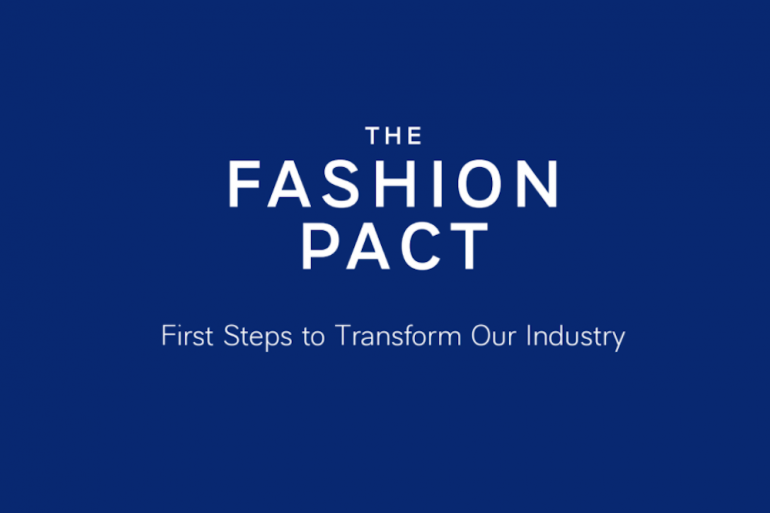For the first time in the Fashion industry, the Fashion Pact unites CEOs of 60+ global leading companies from the fashion and textile industry – fashion, sports, lifestyle and luxury as well as suppliers and retailers – committing to a common core of ambitious quantified environmental objectives focusing on three themes: climate, biodiversity and oceans.
SEE ALSO : Kering opens new headquarters in Japan
Members have identified seven strategic tangible targets – across the three themes – with the support of some of the best technical experts, particularly in the areas where collaborative action is needed to scale solutions in order to achieve critical impact on a global scale.
One year since its creation, membership has doubled to 60+ signatories, stemming across multiple sectors and 14 countries, together representing over 200 brands and 1/3 of the fashion industry. This level of diversity and reach is key to ensure end-to-end impact along the supply chain.
The Fashion Pact is still at the beginning of its impact. The coalition has made its first strides, including implementing an operations structure, developing a digital dashboard of KPIs to measure joint impact as well as beginning first collaborative activity on biodiversity together with the technical expertise of industry experts.
Last Year, “The Fashion Pact” was created and presented to heads of state during the G7 meeting at Biarritz. 32 groups and brands in luxury, retail, fashion, and sports and lifestyle had decided to join this new industry coalition and to commit to collectively spearhead transformative industry change through action and by building upon and going beyond existing initiatives. Since its establishment, the Fashion Pact has organized itself as a CEO-led coalition, with a 14-member Steering Committee that is supported by a CSO 23-member Operations Committee and a secretariat Task Force.
The signatories have set 7 tangible targets for climate, biodiversity, oceans, supported by some of the leading experts across research, science, and conservation. In order to measure progress and steer actions towards impact, the pact has established a digital dashboard of KPIs around its three pillars, developed with the strategic reporting support of the Boston Consulting Group (BCG).
Climate
The Fashion Pact’s signatories have committed to the implementation of Science Based Targets (SBTs) for Climate to achieve net-zero carbon impact by 2050:
1) implementing the principles of the U.N. Fashion Charter,
2) achieving 25% low-impact materials sourcing by 2025, and
3) achieving 50% renewable energy by 2025, and 100% by 2030 in their own operations.
In order to deliver on these targets, the Fashion Pact is engaging with key climate experts in the industry, starting with 2050 & SYSTEMIQ who have mapped out strategic areas for collective efforts, without duplicating existing initiatives, to inform business decisions and to provide assistance in accurate reporting and target-setting.
Within most companies, significant individual action is already underway to reduce GHG emissions. Together, signatories have achieved reductions of ~350-450k tons of GHG emissions (CO2 equivalent) across Scope 1 & 2. Members achieved significant progress towards the transition to lower climate impact raw materials with, for example, ~40% of reported cotton volume of members being lower impact, as well as having 1/3 of signatories on track to achieving 50% renewable energy in 2020.
Biodiversity
Biodiversity is still an emergent issue of focus within the fashion industry, but is crucial for business reliant on nature-based resources. Concretely, in this pillar, the Fashion Pact has committed to the protection of key species as well as the protection and restoration of critical natural ecosystems.
Committed to driving action rooted in technical expertise and science, The Fashion Pact and Conservation International have worked towards three main outcomes: first, a calculated and detailed plan of action for the next two years for both individual and collective action. Second, the building of partnerships with key global experts and institutions to support the technical work. Third, the scouting for support for the scientific analyses and approaches that will help shape our biodiversity outcomes.
To kick-off first actions, The Fashion Pact has come together in a series of webinars, named the “Nature of Fashion”, where , together with key conservation experts, members worked jointly on topics such as how to map your supply chain for biodiversity, creating Science Based Targets for Nature, and developing biodiversity strategies.
As first tangible targets, members have committed to:
1) individual biodiversity blueprints by the end of 2020, and
2) supporting zero deforestation and sustainable forest management by 2025. 80% of signatories had not had a public biodiversity commitment prior to joining the Fashion Pact, and 50% have reported that their membership has inspired their organization’s development of actions or commitments to prevent deforestation.
Oceans
In the Oceans pillar, The Fashion Pact’s first area of focus is on eliminating problematic and unnecessary plastic in packaging (including polybags, hangers, consumer packaging, and retail bags).
Signatories will:
1) achieve the elimination of problematic and unnecessary packaging in B2C packaging by 2025 and in B2B by 2030
2) ensure that at least half of other plastic packaging in B2C is 100% recycled content by 2025, and by 2030 for B2B.
These first actions were selected as the Fashion Pact is dedicated to making a tangible impact.
SEE ALSO : Fosun acquires fashion label Tom Tailor
Achieving the targets will require scaling innovation and successful pilots, a sphere where the coalition is uniquely equipped to leverage its weight to accelerate impact.
Individual achievement in this space is varied – for example, 60% of signatory brands have eliminated plastic packaging in their retail bags, whereas there have been a lot of challenges in hangers and B2B transport bags, with only 15% of signatories having achieved elimination. Despite the different levels of progress, collective action can scale innovation to close the gap. The Fashion Pact is currently working with (RE)SET to call innovators to action and use the weight of the collective to scale innovative solutions.




